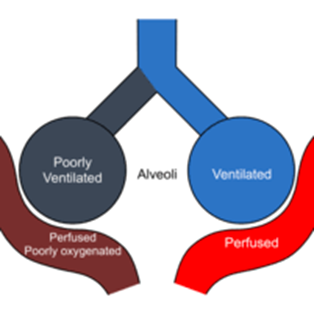A nurse is caring for a client with manifestations of status asthmaticus. Which of the following factors play a role in creating circulatory surge of inflammatory cells and cytokines in this condition? (Select all that apply.)
(Select All that Apply.)
Epithelial cells
OT lymphocytes
Hyperreactivity
Mast cells
Inflammation
Correct Answer : A,D,E
Choice A Reason:
Epithelial cells is correct. Epithelial cells lining the airways play a role in initiating the inflammatory response in asthma by releasing cytokines and other inflammatory mediators. These cells can contribute to the circulatory surge of inflammatory cells and cytokines seen in status asthmaticus.
Choice B Reason:
OT lymphocytes is incorrect. There is no specific cell type known as "OT lymphocytes." It's possible this may refer to T lymphocytes (T cells), which are involved in the immune response in asthma but are not typically associated with a circulatory surge in status asthmaticus.
Choice C Reason:
Hyperreactivity is incorrect. Hyperreactivity refers to the exaggerated response of the airways to various stimuli, leading to bronchoconstriction and inflammation. While hyperreactivity is a characteristic feature of asthma, it does not directly contribute to a circulatory surge of inflammatory cells and cytokines.
Choice D Reason:
Mast cells is correct. Mast cells are key players in the pathophysiology of asthma. They release various inflammatory mediators, including histamine and leukotrienes, which contribute to airway inflammation, bronchoconstriction, and mucus production. Mast cells can participate in the circulatory surge of inflammatory cells and cytokines in status asthmaticus.
Choice E Reason:
Inflammation is correct. Inflammation is a hallmark feature of asthma and plays a central role in the pathogenesis of status asthmaticus. The inflammatory response involves the recruitment and activation of various inflammatory cells, release of cytokines, and other mediators that contribute to airway obstruction and systemic effects.
Nursing Test Bank
Naxlex Comprehensive Predictor Exams
Related Questions
Correct Answer is D
Explanation
Choice A Reason:
Dulaglutide is inappropriate. Dulaglutide is a medication used to treat type 2 diabetes by improving blood sugar control. It is not indicated for the management of neurogenic bladder or urinary incontinence.
Choice B Reason:
Montelukast sodium is inappropriate. Montelukast sodium is a medication primarily used to treat asthma and allergic rhinitis by blocking leukotrienes, which are inflammatory substances that contribute to asthma and allergy symptoms. It is not indicated for the management of neurogenic bladder or urinary incontinence.
Choice C Reason:
Glatiramer acetate is inappropriate. Glatiramer acetate is a medication used to treat relapsing-remitting multiple sclerosis (MS) by modulating the immune system. It is not indicated for the management of neurogenic bladder or urinary incontinence.
Choice D Reason:
Oxybutynin is appropriate. Oxybutynin is a medication commonly prescribed for the management of neurogenic bladder and urinary incontinence. It belongs to a class of medications called anticholinergics, which work by relaxing the bladder muscles and reducing bladder spasms. Oxybutynin helps control urinary urgency, frequency, and incontinence associated with neurogenic bladder, including spasm-induced incontinence.
Correct Answer is B
Explanation
Choice A Reason:
Flail chest is incorrect. Flail chest is a condition characterized by multiple rib fractures, causing instability in the chest wall. While it can lead to respiratory distress, it doesn't directly cause ventilation-perfusion (V/Q) mismatch. Instead, it impairs the mechanics of breathing by compromising chest wall integrity.
Choice B Reason:
Emphysema is a chronic obstructive pulmonary disease (COPD) where the alveolar walls are destroyed, leading to a loss of surface area for gas exchange. This results in areas of the lungs that are well-perfused but poorly ventilated, causing a V/Q mismatch. The damage to alveoli leads to impaired ventilation, while blood flow may still be adequate, leading to hypoxemia (low oxygen levels in the blood).
Choice C Reason:
CHF primarily affects the heart’s ability to pump blood effectively, leading to pulmonary congestion and impaired gas exchange. However, it typically causes diffusion defects rather than a direct ventilation-perfusion mismatch. V/Q mismatch may occur secondary to pulmonary edema, but it’s not the primary mechanism of respiratory failure in CHF.
Choice D Reason:
Guillain-Barré syndrome is incorrect. Guillain-Barré syndrome (GBS) is a neurological disorder that affects the peripheral nervous system, leading to muscle weakness and paralysis. While respiratory muscle weakness can occur in GBS, it doesn't directly cause ventilation-perfusion (V/Q) mismatch. GBS primarily affects nerve function rather than lung function.

Whether you are a student looking to ace your exams or a practicing nurse seeking to enhance your expertise , our nursing education contents will empower you with the confidence and competence to make a difference in the lives of patients and become a respected leader in the healthcare field.
Visit Naxlex, invest in your future and unlock endless possibilities with our unparalleled nursing education contents today
Report Wrong Answer on the Current Question
Do you disagree with the answer? If yes, what is your expected answer? Explain.
Kindly be descriptive with the issue you are facing.
